

Creativelive. It's time to face the hard, data-driven truth that your corporate learning programs are likely serving your men better than your women.

Many organizations unknowingly perpetuate the gender leadership gap by giving more time, energy, and resources to helping men rise. In doing so, intentionally or not, businesses deny women opportunities to gain the critical leadership skills necessary for advancement—opportunities to which many men have always had access. Mindset matters: why leadership training needs to change. Business schools need to shift their thinking or risk becoming irrelevant.
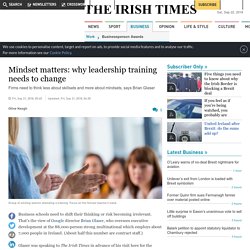
That’s the view of Google director Brian Glaser, who oversees executive development at the 88,000-person strong multinational which employs about 7,000 people in Ireland. (About half this number are contract staff.) How Strong is Your Leadership Pyramid? - Executive Coach - Management - GovExec.com. Successfully transitioning to new leadership roles. Leadership changes are more common and important than ever.
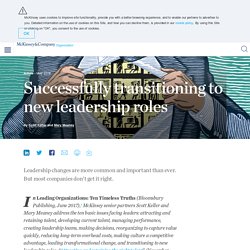
But most companies don’t get it right. In Leading Organizations: Ten Timeless Truths (Bloomsbury Publishing, June 2017), McKinsey senior partners Scott Keller and Mary Meaney address the ten basic issues facing leaders: attracting and retaining talent, developing current talent, managing performance, creating leadership teams, making decisions, reorganizing to capture value quickly, reducing long-term overhead costs, making culture a competitive advantage, leading transformational change, and transitioning to new leadership roles. “Attracting and retaining the right talent” (November 2017) was the first in our series of articles based on the book.
The second was “Reorganizing to capture maximum value quickly” (February 2018). Every leadership transition creates uncertainty. Is It Time to Rethink Leadership Development. When people’s psychological needs for autonomy, relatedness and competence are satisfied, they experience optimal motivation — the type of motivation empirically proven to fuel employee work passion and five important intentions, which are to: Stay in the organization.Endorse the organization and its leadership.
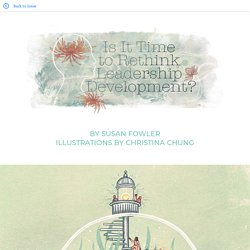
Use organizational citizenship behaviors.Perform at above standard expectations.Use discretionary effort on behalf of the organization. Are people motivated by money, power and pressure? Yes. Degreed LENS 2017 – Curation Panel Discussion - St. Charles Consulting Group. What’s missing in leadership development? Only a few actions matter, and they require the CEO’s attention.
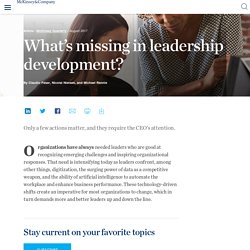
Organizations have always needed leaders who are good at recognizing emerging challenges and inspiring organizational responses. That need is intensifying today as leaders confront, among other things, digitization, the surging power of data as a competitive weapon, and the ability of artificial intelligence to automate the workplace and enhance business performance. These technology-driven shifts create an imperative for most organizations to change, which in turn demands more and better leaders up and down the line. Unfortunately, there is overwhelming evidence that the plethora of services, books, articles, seminars, conferences, and TED-like talks purporting to have the answers—a global industry estimated to be worth more than $50 billion—are delivering disappointing results.
Focus on the shifts that matter. Leadership in innovation needs innovation in leadership. As businesses face evolving challenges, four aspects of leadership will become dramatically more important: insight, integrity, courage, and agility.

It may be that advancing technology plays the most visible role in shaping manufacturing progress in the years ahead. But we believe that what will matter at least as much for manufacturing’s future is something that’s much less visible, even though it has long been the bedrock of performance: effective leadership. How individual leaders inspire and influence others will become a key differentiator between organizations that thrive and those that do not. In our experience transforming large, complex organizations at scale, the bulk of the work is usually in creating operational and managerial solutions. Google Spent Years Studying Effective Bosses. Now They Teach New Managers These 6 Things. The transition from individual contributor to manager is not an easy one.
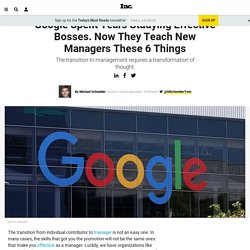
In many cases, the skills that got you the promotion will not be the same ones that make you effective as a manager. Luckily, we have organizations like Google that have spent years researching this transition, to help us demystify the secrets to new managers' success. Using Project Oxygen, an internal study that analyzed more than 10,000 manager impressions including performance reviews, surveys, and nominations for top-manager awards and recognition, Google identified eight habits of highly effective managers.
Google also designed a management training workshop to share its newfound knowledge with its bosses and now the world. How to Appreciate and Develop 'Quiet' Leadership. PHOENIX—Is the ideal leader bold, alpha and gregarious?

"We live in a culture that tells us the answer is decidedly, 'Yes,'" Susan Cain told the opening session of the WorkHuman 2017 conference sponsored by Globoforce, an employee engagement and recognition software company. Cain, co-founder of the Quiet Leadership Institute, called on HR professionals to expand the model of what leadership looks like. While people tend to think of the lone extroverted leader who saves the day, companies are better served by "the yin and yang" of introverted and extroverted leaders who complement and balance each other, said Cain, author of the bestseller Quiet: The Power of Introverts in a World That Can't Stop Talking (Broadway Books 2013).
Introverted leaders may seem unassuming and soft spoken but "introverts are so into what they're doing. People can feel when a leader is there because they have no choice" but to follow their passion. Neuroscience Says These Are the 8 Best Ways to Build Trust in the Workplace. Finding hidden leaders. Organizations should learn to hunt, fish, and trawl for the best talent.
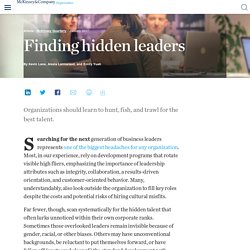
Searching for the next generation of business leaders represents one of the biggest headaches for any organization. Most, in our experience, rely on development programs that rotate visible high fliers, emphasizing the importance of leadership attributes such as integrity, collaboration, a results-driven orientation, and customer-oriented behavior. Many, understandably, also look outside the organization to fill key roles despite the costs and potential risks of hiring cultural misfits. 4 Ways to Improve Your Strategic Thinking Skills. Executive Summary If you believe that strategic thinking is only for senior executives, think again.

It can, and must, happen at every level of the organization; it’s one of those unwritten parts of all job descriptions. Once you’ve accepted that it’s part of your job, focus on developing four key abilities that demonstrate your strategic prowess. First, routinely explore the internal trends in your daily work, like issues that come up repeatedly. The second ability is asking tough questions: “What does success look like in Year 1? What’s stalling progress for women at work? Corporate America’s gender-diversity programs are falling short. Companies need to think differently to ignite change. Although gender inequality increasingly concerns many companies, research from McKinsey and LeanIn.org shows few organizations have programs in place that truly address the issue.
Your Leadership Development Program Needs an Overhaul. Most companies make big investments in leadership development, rolling out intensive internal programs for high potentials, sending key leaders off to expensive executive education programs, or hiring personal coaches for those moving into key positions at the top of the company. But in our experience, this traditional approach to leadership development doesn’t serve the needs of companies anymore. Business is moving too fast. Our experience suggests that an overhaul in leadership development is not only possible, it’s necessary to stay competitive. Forbes Welcome. Functions/organization/our-insights/leadership-and-behavior-mastering.
Women in the Workplace 2016. In corporate America, women fall behind early and keep losing ground with every step. More than 75 percent of CEOs include gender equality in their top ten business priorities, but gender outcomes across the largest companies are not changing. Women are less likely to receive the first critical promotion to manager—so far fewer end up on the path to leadership—and they are less likely to be hired into more senior positions. As a result, the higher you look in companies, the fewer women you see. Women in the Workplace 2016, a study conducted by LeanIn.Org and McKinsey, elaborates on these patterns, provides some explanations for them, and suggests priorities for leaders seeking to speed the rate of progress.
Key findings, based on data from more than 130 companies and over 34,000 men and women, include the following: 4 Signs You're a Leader Who Inspires Others (and Makes Work Worthwhile) Somebody asked me the difference between management and leadership. In a rush to a meeting, I said, “You manage the work, and you lead your followers.” Sure, in the context of the day-to-day corporate grind, you can’t have one without the other.
How centered leaders achieve extraordinary results. Executives can thrive at work and in life by adopting a leadership model that revolves around finding their strengths and connecting with others. For the past six years, we have been on a journey to learn from leaders who are able to find the best in themselves and in turn inspire, engage, and mobilize others, even in the most demanding circumstances. And the business environment has become more demanding: the global financial crisis and subsequent economic downturn have ratcheted up the pressure on leaders already grappling with a world in transformation. More than half of the CEOs we and our colleagues have spoken with in the past year have said that their organization must fundamentally rethink its business model.
When to change how you lead. Lead at your best. Developing leaders in a business. Decoding leadership: What really matters. The 5 Real Reasons Business Leaders Fail at Culture Management – RoundPegg. You Almost Certainly Have This Toxic Leadership Habit. How centered leaders achieve extraordinary results. Daniel Kahneman: Beware the ‘inside view’ The executive’s guide to better listening. Top executives need feedback. Leading in the 21st century. How leaders kill meaning at work. Leadership lessons from the Royal Navy. 10 Tips To Help You Win Every Negotiation. How to figure out what you're good at (not just what you're passionate about)
8 Signs an Employee Is Exceptional (Which Never Appear on Performance Evaluat... The Dutch are direct, Canadians are diplomats. How leadership styles vary aro... How Do Your Employees Define Career Success? This is How Effective Leaders Move Beyond Blame. How Do Your Employees Define Career Success? What 11 Highly Successful People Do To Stay Motivated.
Getting beyond the BS of leadership literature. What Personality Tests Really Reveal. Leadership in context. Kick-start your career in 2016: New Year, New you - RTÉ Lifestyle.